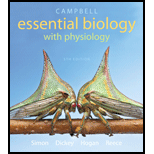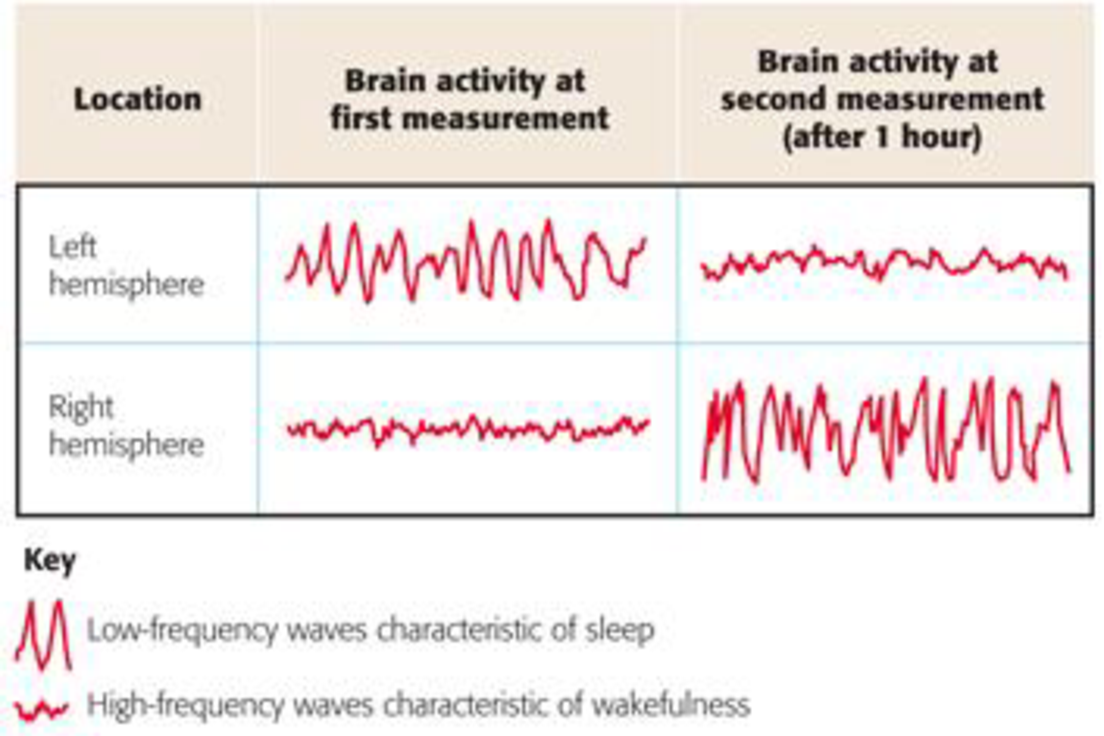
Concept explainers
Interpreting Data Marine mammals, such as seals, whales, and dolphins, have adapted to their watery environment in many ways, including a respiratory system that allows for long underwater dives and a language used to communicate through water Another adaption studied by researchers involves bottlenose dolphins. These dolphins spend approximately 33% of a 24-hour day with one eye open and the other closed, alternating which eye is open and which is closed at intervals of approximately 1 hour. During this time, the animals continuously swim and intermittently rise to the surface of the water to breathe air. Look below at data collected on brain activity in bottlenose dolphins. Why do the dolphins swim with one eye open and the other eye closed—that is, what are they doing? How does their brain activity relate to what is happening with their eyes? Why might this be a successful adaptation?

Want to see the full answer?
Check out a sample textbook solution
Chapter 27 Solutions
Campbell Essential Biology with Physiology (5th Edition)
Additional Science Textbook Solutions
Physics for Scientists and Engineers
Laboratory Manual For Human Anatomy & Physiology
SEELEY'S ANATOMY+PHYSIOLOGY
Biology: Life on Earth with Physiology (11th Edition)
Cosmic Perspective Fundamentals
- Describe how a sound pressure wave that arrives at a vertebrate tympanic membrane is converted between various forms of energy (e.g., electrical) before the brain can integrate the information contained in it.arrow_forward“Animal personality” has been defined as consistent differences between individuals that persist over time. Briffa & Greenaway (2011) studied wild beadlet anemones (Actinia equina) to see whether they display ‘personalities’. They disturbed individual anemones with a jet of water (which causes their tentacles to retract) then recorded how long it took each anemone to reopen (seconds). The experiment was then repeated two weeks later to see whether individual anemones showed consistent reopening times (consistency indicates they have ‘personalities). a)Sketch an appropriate graph to show whether any association exists between the day 1 and day 14 anemone responses. What kind of graph is it? b)Is a strong association present? (i.e., do anemone’s have ‘personalities’?) Pls help with the following question asap and explainarrow_forwardThinking Analytically Do you think there are more species of animals on land or in the ocean? What about absolute numbers of animals—are there more animals on land or in the ocean?arrow_forward
- The tympanic membrane is a covering that transmits sound to the inner portions of the frog ear. It doesn’t detect sound – it just transmits it. It would be similar to how the human eardrum works. It also protects the frog ear from water/debris. Some frogs have large external tympanic membranes; others have very small ones. Some frogs do not have them at all – they transmit sound to their ears in other ways. Look at the Coastal Plains leopard frog and the bull frog. Be able to identify the tympanic membranes, and the dorsolateral or supratympanic folds on both. Q18: can you please answer (type) both parts of this question A: What do you notice when you compare the glandular folds on the two frogs? And what does “supratympanic” mean? Why does that make sense?arrow_forwardJackrabbits (Figure 7) live in the desert where they are exposed to extremely hot daytime temperatures. Discuss how the large ears and circulatory system help them to stay cool in areas without much shade and the benefits of this strategy.arrow_forwardListen The following passage comes from an abstract in a study about analyzing hearing loss in twins: "A clinical and genetic study on 25 twin pairs with at least one deaf member was performed. Concordance rate of hearing loss was 0.88 in MZ and 0.50 in DZ pairs" (MZ =monozygotic or identical twins. DZ -Dizygotic or fraternal twins). From this data alone, what can you conclude about the roles of environment and genetics in hearing loss? Explain how you reached your conclusion.arrow_forward
- Biology. Please help.arrow_forwardVISUALIZE Describe the action taking place at each of the numbered steps in the figure.arrow_forwardEVOLUTION LINK CREB has been shown to be a signaling molecule in the memory pathway in many animals, including fruit flies and mice. What does that suggest about the evolution of learning and memory?arrow_forward
- Propose a hypothesis as to why the human visual system evolved to respond more to moving stimuli that static stimuli and describe how you would test this hypothesisarrow_forwardThe function of the vertebrate eye is unusual compared with other processes found within the body. For example, the direction in which sensory information flows is actually opposite to the path that light takes through the retina. Explain the sequence of events involved in the movement of light and information through the structures of the eye and explain why they move in opposite directions. Compare this sequence to the functioning of the Mollusk eye.arrow_forwardReview the summary of a published scientific study below: Patients with multiple sclerosis frequently suffer from blurred vision. Drug X was developed to reduce blurred vision in healthy patients, but the effectiveness had not been tested on those suffering from multiple sclerosis. A study was conducted to determine if Drug X is effective at reducing blurry vision in multiple sclerosis patients. To be considered effective, a drug must reduce blurred vision by more than 30% in patients. Researchers predicted that a 20 mg dose of the drug would be effective for treating blurred vision in multiple sclerosis patients by reducing blurred vision by more than 30%. Drug X was administered to groups of multiple sclerosis patients at three doses (10 mg/day, 20 mg/day, 30 mg/day) for three weeks. A fourth group of patients was given a placebo containing no drug X for the same length of time. Vision clarity was measured for each patient before and after the three-week period using a standard…arrow_forward
 Biology: The Dynamic Science (MindTap Course List)BiologyISBN:9781305389892Author:Peter J. Russell, Paul E. Hertz, Beverly McMillanPublisher:Cengage Learning
Biology: The Dynamic Science (MindTap Course List)BiologyISBN:9781305389892Author:Peter J. Russell, Paul E. Hertz, Beverly McMillanPublisher:Cengage Learning Biology 2eBiologyISBN:9781947172517Author:Matthew Douglas, Jung Choi, Mary Ann ClarkPublisher:OpenStax
Biology 2eBiologyISBN:9781947172517Author:Matthew Douglas, Jung Choi, Mary Ann ClarkPublisher:OpenStax Biology (MindTap Course List)BiologyISBN:9781337392938Author:Eldra Solomon, Charles Martin, Diana W. Martin, Linda R. BergPublisher:Cengage Learning
Biology (MindTap Course List)BiologyISBN:9781337392938Author:Eldra Solomon, Charles Martin, Diana W. Martin, Linda R. BergPublisher:Cengage Learning


